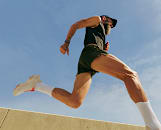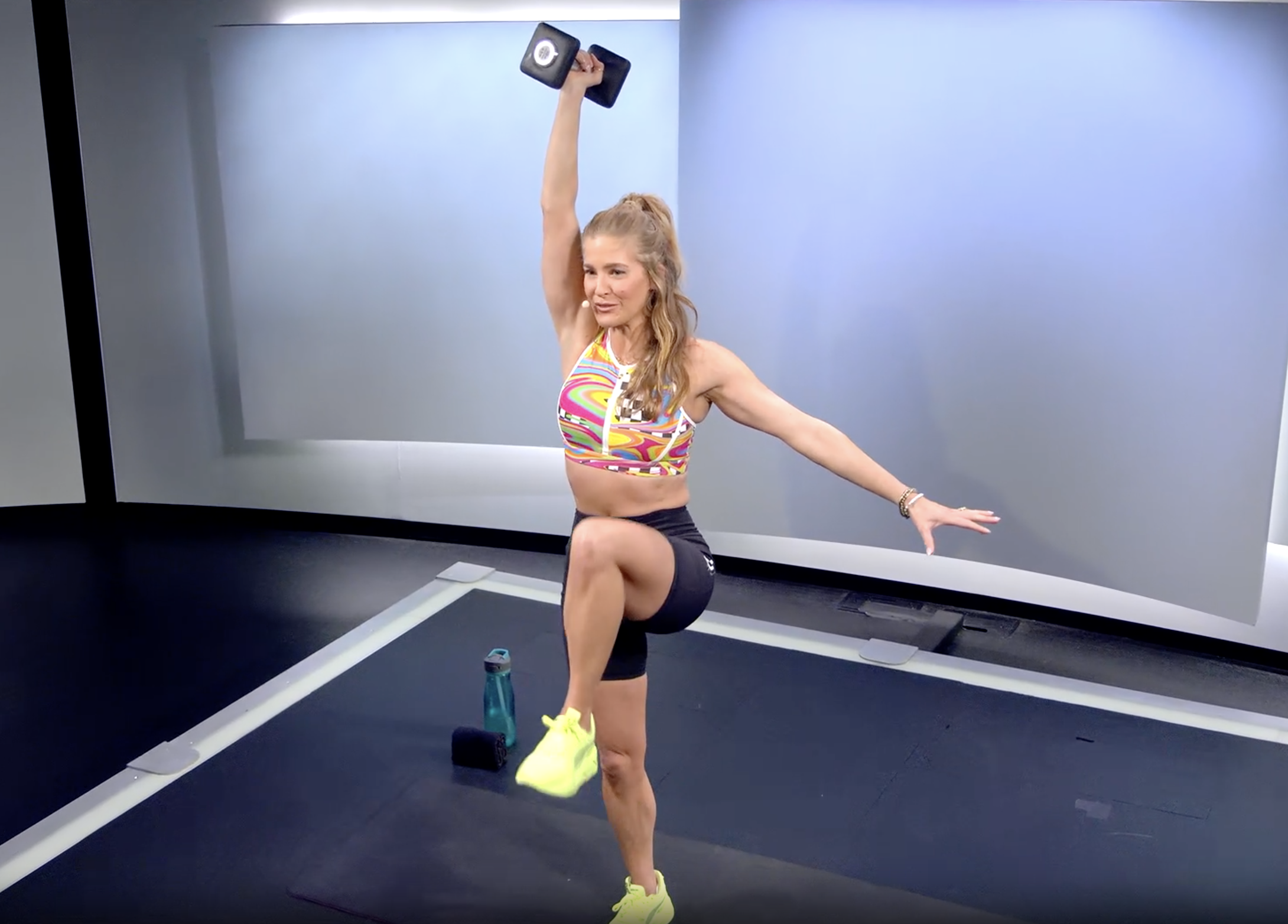
Tired of Crunches? Try These 15 Standing Core Exercises
They can be just as challenging as mat exercises—and even more effective.
By Michele Ross•
What Are Standing Core Exercises?
How Standing Exercises Engage Your Core
The Benefits of Standing Core Exercises
15 Standing Core Exercises to Try
Are Standing Core Exercises Safe to Do During Pregnancy?
What Muscles Do Standing Core Exercises Work?
How to Add Standing Core Exercises to Your Fitness Routine
The Takeaway
I have a confession: As much as I love to exercise, it takes a lot for me to gather self-discipline for a dedicated ab workout. When I’m supine on my mat, it’s usually only a matter of minutes before my neck and hips start to ache. (To those with lower back pain, I see you, too.) If these roadblocks sound familiar but you still want to fire up your midsection, I’d like to introduce you to a highly accessible and challenging variation: standing core exercises.
Discover more ways to reach your goals with Peloton
Not only are standing core exercises a great alternative to mat work, but in many ways, they’re superior. “Standing core is the most functional way to train your core,” says Peloton instructor Rebecca Kennedy.
Down to give them a try? In this guide to standing core exercises, Rebecca outlines their key benefits and the best moves to target your abs—and sometimes even your full body.
What Are Standing Core Exercises?
Standing core exercises are exactly what they sound like: moves that target the core muscles and are performed while standing.
In many cases, these exercises are variations of popular ab work performed on the mat, Rebecca says. For example, a classic crunch simply becomes a standing crunch, and cat cow becomes a standing cat cow. However, because you’re doing the exercise standing up instead of lying down, you’re not only engaging your core but many other muscles in the body too.
“The cool thing about all of this is that they’re mostly familiar exercises found in core and full body classes, so the learning curve is low,” Rebecca says. “The challenges and work feel subtle and not overwhelmingly difficult, but often have a much higher efficacy to mat work. Standing core exercises also move slowly and build over the class, making it a great option for all ages and levels.”

Peloton App
Access thousands of classes with no equipment needed.
How Standing Exercises Engage Your Core
Now, for the million-dollar question: How can standing core exercises be easier yet more effective than ab workouts performed on the mat? To start, when you’re working the core from a standing position, you have to move against gravity and keep your balance. This requires greater muscle activation to remain stable.
“Any time you transition movements to different planes of motion, you recruit more muscle groups and open up to new variables like stability, balance, posture, and weight transfer,” Rebecca explains. “Let’s also not forget that when we bring core bracing, breathwork, and pelvic floor engagement from a supine position to standing, it magnifies its potency.”
Need some context? Rebecca offers the example of a basic supine crunch, which she says will focus primarily on the rectus abdominis, the abdominal muscles that run along the front of your stomach and work to bend your torso forward. A standing crunch, on the other hand, will also include:
Your lower body in a half squat, engaging your legs and glutes
Your postural muscles, working to bend and straighten your spine
Your deep core muscles, which are more engaged without the floor supporting your back
“For many core exercises, the closer to the ground [you are], the less difficult and lower muscle recruitment per variation it is,” Rebecca notes. Another example illustrating this is the woodchop exercise. She says it involves the least muscle recruitment while seated (since you’re only activating muscles above the hips), more while you’re kneeling, and the most while doing alternating standing reps (which requires full-body effort). “More muscles used equals more dynamic movements and higher metabolic output,” she adds.
The Benefits of Standing Core Exercises
There’s almost no reason not to do this type of exercise; the benefits of standing core workouts are multifold and major. After reading the specifics below, you’ll get on board, too.
They’re Highly Accessible
So long as you can support your weight and stay balanced on your feet, standing core exercises can benefit all types of people—independent of your age, fitness level, or goal. They also tend to be low and slow, making them a good choice for people with diverse needs and backgrounds. (This includes those of us who deal with neck, back, or hip pain, which may heighten with some types of supine ab work.)
According to Rebecca, standing core exercises can amplify your workout routine “whether you’re training for a marathon, postpartum, coming back from an injury, in a strength training program, or getting started in your fitness journey.” Better yet, you don’t need to rely on a mat or fancy equipment to get a session in. In most cases, it’s an “anywhere, anytime” type of workout, so the convenience factor is also a wonderful perk.
Standing core strength classes on the Peloton App, for example, are short but sweet, clocking in at five to 20 minutes long. Some require bodyweight only, while others include light or medium dumbbells or a hand towel. While these props are optional, they “play significant roles in the efficacy of each exercise and promote posture, strength, and resistance when needed,” Rebecca explains.
They Enhance Functional Movement
Countless movements in daily life—including but not limited to getting out of bed, climbing stairs, and turning around—involve the core. Many of these are performed in an upright position, so training your core while standing can train your body to safely execute those motions. “Once on our feet, we feel what it would truly be like to maintain that same level of engagement when we are at work, holding our kids, or putting on a pair of heels,” Rebecca says.
Raymond Agostino, a doctor of physical therapy and owner of Agostino Athletics, also prizes their full-body integration. “Unlike traditional mat core exercises, standing movements recruit the entire kinetic chain, improving stability, endurance, and power for both daily life and athletic performance,” he shares.
They Boost Your Performance for Other Workouts
In addition to preparing you for functional movements that show up in everyday life, standing core exercises also often mimic strength training exercises (think: squats and deadlifts, among others). According to Rebecca, they’re especially beneficial for preparing you to lift weights. Take deadlifts, for example. “When we deadlift, we’re hinging at our hips with a neutral spine, while holding onto heavy weights,” she says. “In standing core, we practice good mornings and standing bird dogs; both mimic the deadlift without the weights. This creates greater muscle memory and acts as movement prep for direct crossover into our strength training.”
That’s not all. “The coolest results are when members notice real improvements in [things like] their running pace, how they feel during their strength training—whether it’s form or ability to increase weights—better balance in single-leg work, core power and endurance during Power Zone rides, etc.,” she says.
They Improve Posture and Balance
“Unlike mat core work, standing core uses all planes of motion: front to back, side to side, and around [or rotational],” Rebecca explains. “It also incorporates different levels, like arms above your head, moving your torso from high to low, maintaining balance on your toes, or getting into a low squat.”
As such, these moves require everything from finding and maintaining your posture to balancing (and rotating) on one leg, which can translate directly to the multiplanar movements you do in sports and life. (Think: Jumping and twisting to hit a tennis ball, or turning and reaching overhead to close the trunk.) Incorporating dynamic movements to the mix, you’re not only scoring a solid core workout but also improving how you’ll hold and move your body even after your sweat sesh is done.
They Enhance Breath Awareness
“I’d argue one of the top benefits is that [standing core] teaches us how to use our breath to align with and supplement our movements,” Rebecca shares. “Learning how to taper your breath, create compression, use it to recover, or perform a difficult movement are a few examples of what makes it so beneficial.” Once you get your breathwork down—namely by inhaling when the core is relaxed and exhaling when it contracts—you’ll not only perform the moves more effectively, but also find that they’re easier to perform for longer periods of time.
15 Standing Core Exercises to Try
Here, Rebecca and Agostino share some of their favorite standing core exercises—both with and without equipment—plus cues on how to perform them safely and effectively.
1. Standing Cat Cow
Stand with your feet hip-width distance apart. Keeping your back straight, hinge at your hips and bend your knees to place your hands on your thighs, just above your knees.
Inhale to arch and extend your spine, reaching the crown of your head up toward the ceiling and slightly backward, if that's comfortable for you.
Then, exhale to round your spine, tucking your tailbone and dropping your chin toward your chest. That’s one rep.
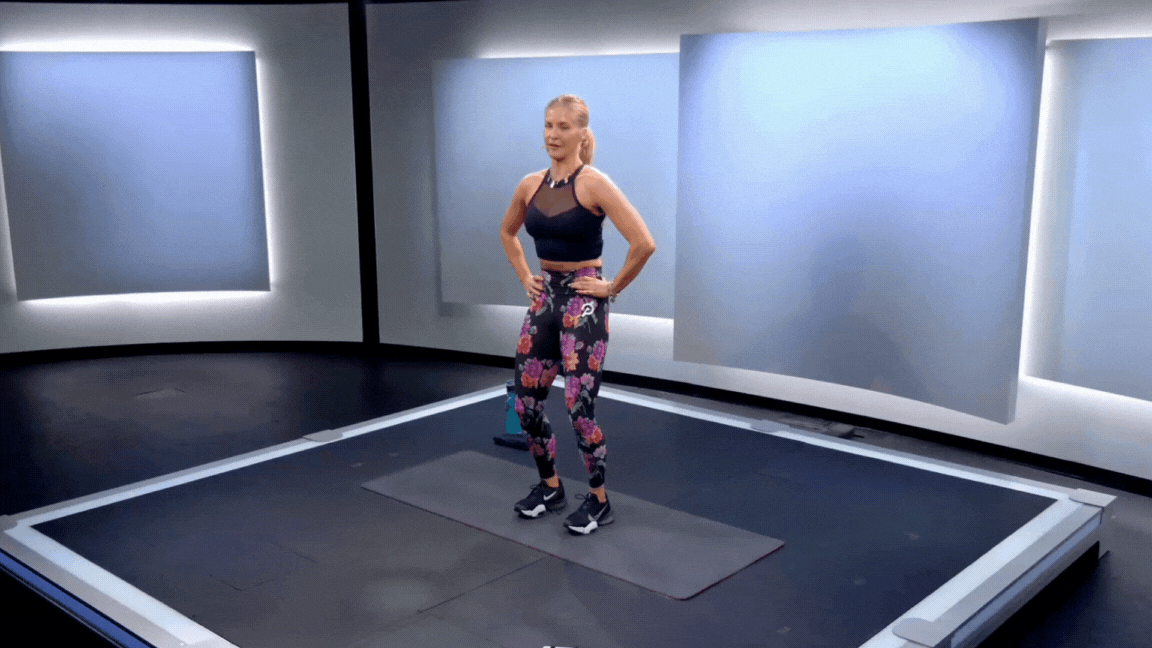
2. Pelvic Tilts
Start standing with your feet hip-width distance apart and your knees softly bent.
Inhale to tilt your pelvis forward, pointing your tailbone backward, arching your back slightly and relaxing the pelvic floor.
Then, exhale and tilt your pelvis backward, tucking your tailbone, drawing your hip bones toward the bottom of your ribs, and squeezing the pelvic floor. That’s one rep.
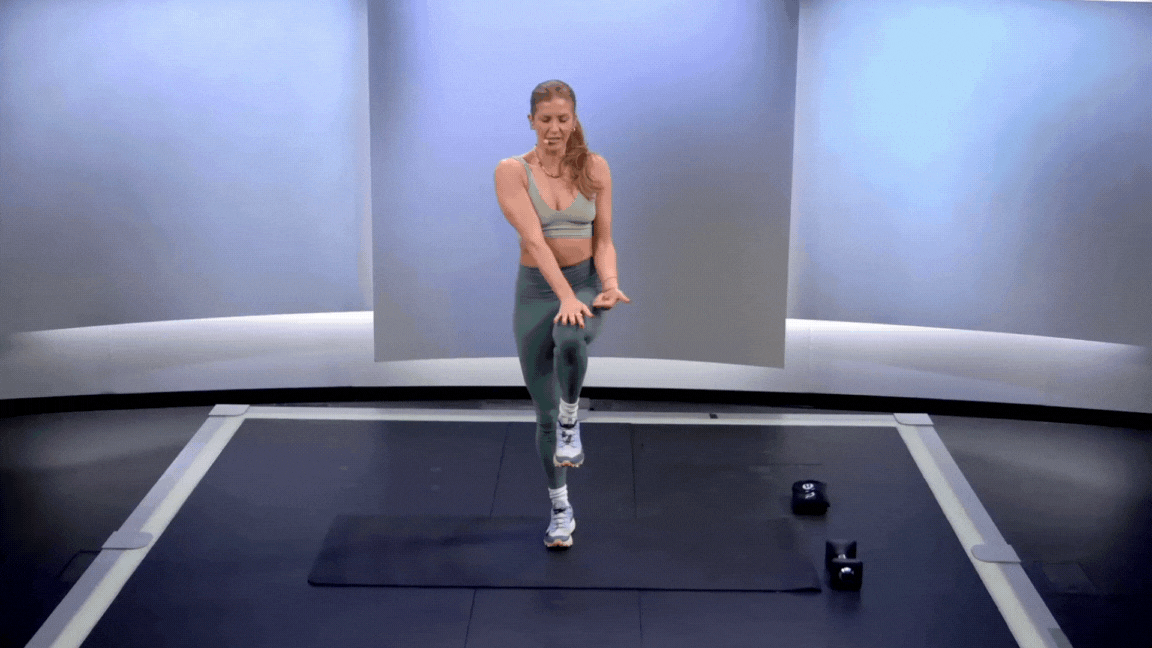
3. Single Leg Isometric Press
Start standing with your feet together. Shift your weight into the right leg and lift your left knee to hip height, bent at about 90 degrees. Make sure your spine is neutral and core core is engaged; don’t allow your back to arch.
Place your right hand on the top of the left thigh and hold, pushing your knee into your hand and your hand into your knee. Continue breathing, using the exhale to really engage your core. (Rebecca suggests thinking about blowing out as many birthday candles as possible.)
Hold for 10-30 seconds, then repeat on the other side.
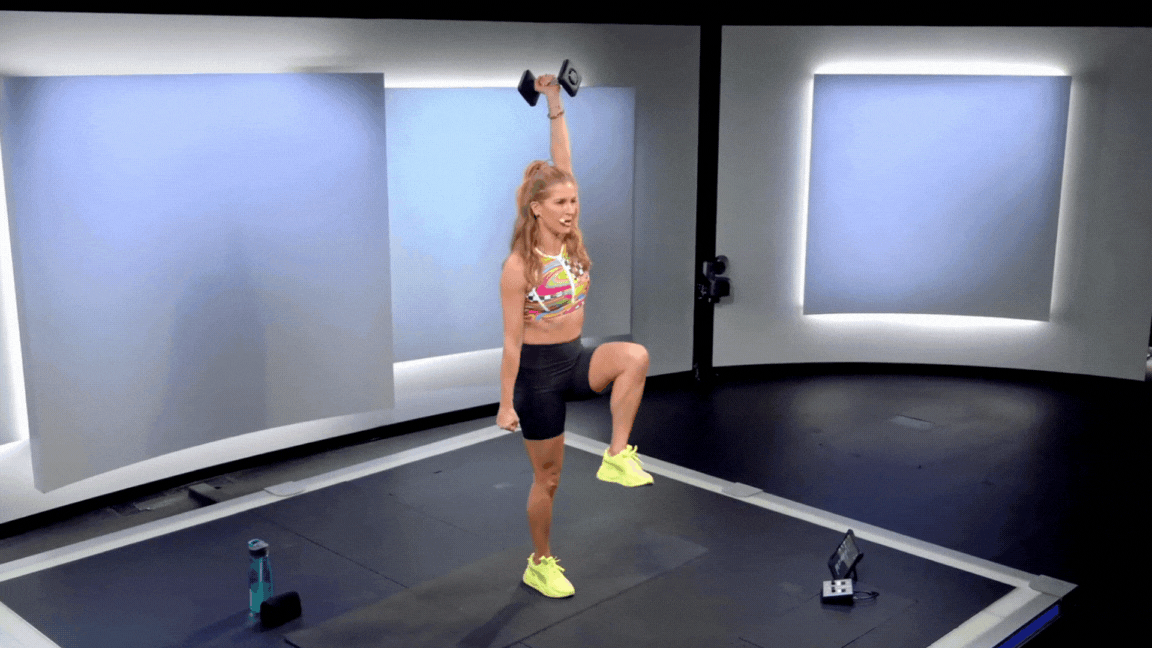
4. Offset Overhead March
Stand with your feet together, holding one medium dumbbell in your right hand. Press it overhead so the weight is directly above your shoulder, bicep by your ear. Engage your core, finding a neutral spine.
Draw your right knee up toward your chest, pausing for one second before lowering your right foot back to the floor. Then, repeat on the other side.
That’s one rep. Continue alternating for 30 seconds, then repeat holding the dumbbell in your left hand.
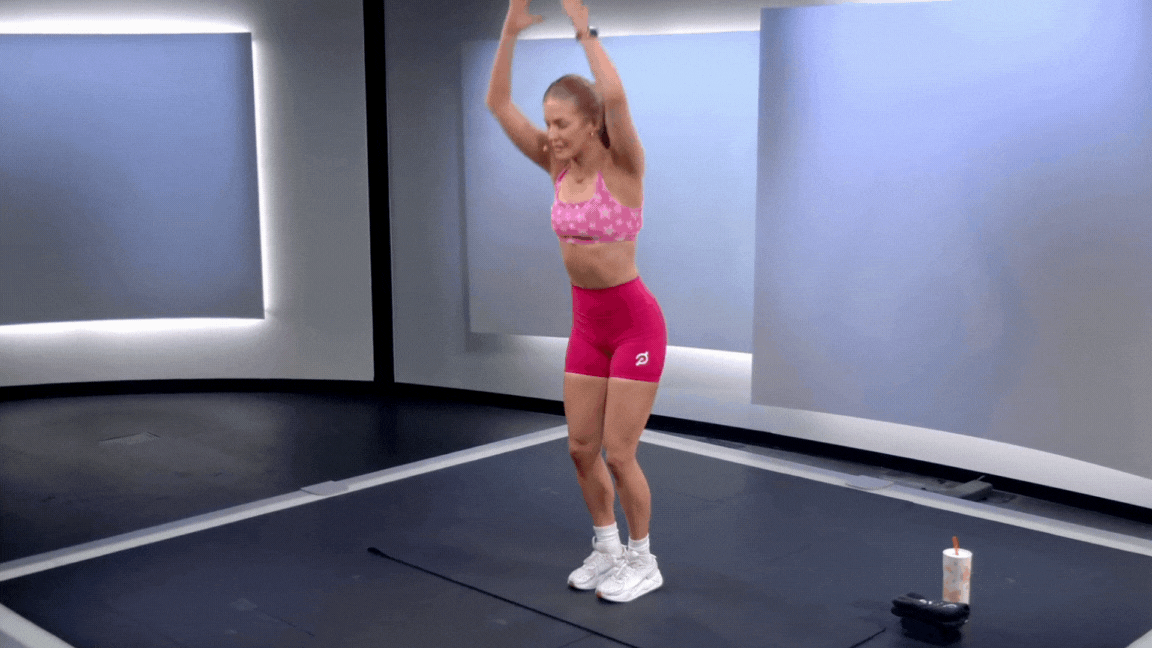
5. Standing Triple Crunch
Start standing with your feet hip-width distance apart and your knees softly bent. Reach your hands overhead, biceps by your ears.
Inhale, then exhale and use your abs to crunch your torso forward, rounding your spine and reaching your elbows toward your knees.
Pulse in this position for three counts total, then inhale and lift your chest, reaching your arms overhead to return to the starting position. That’s one rep.
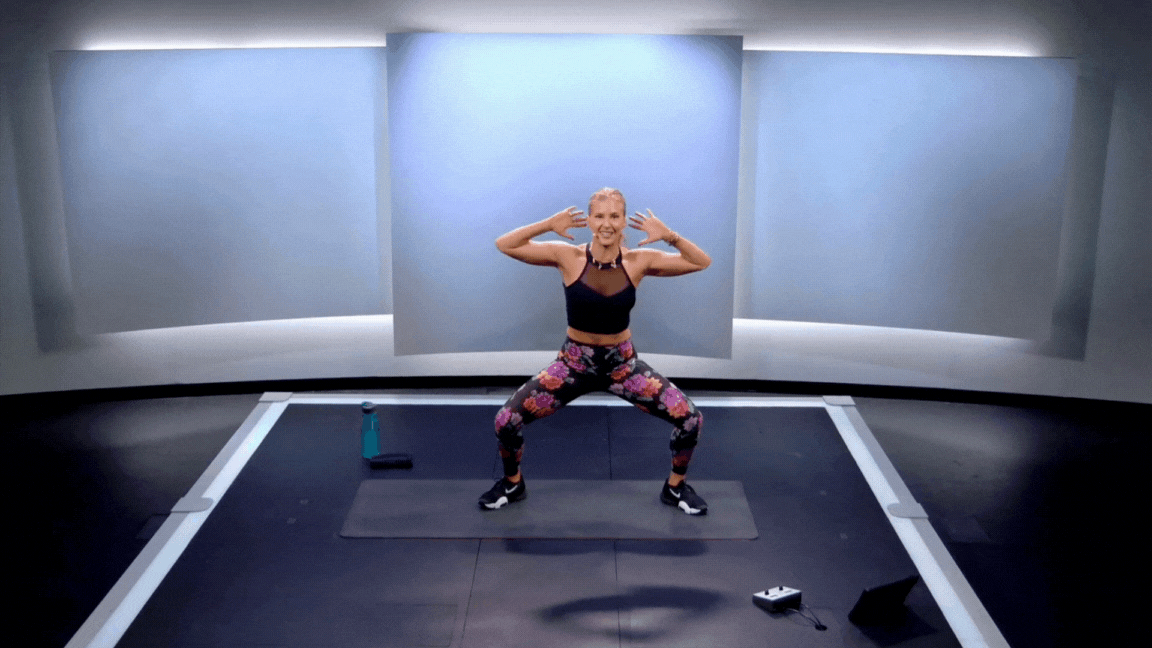
6. Sumo Side Bend
Start standing with your feet wide and your toward pointing slightly outward. Place your hands behind your head, elbows pointing out to the sides. Bend your knees to lower into a sumo squat so your knees are over your ankles and your hips are in line with or slightly above your knees.
Inhale, then exhale to bend sideways at the waist, reaching your right elbow toward your right knee.
Inhale to lift your shoulders and return to center, and repeat on the other side.
That’s one rep. Continue alternating.
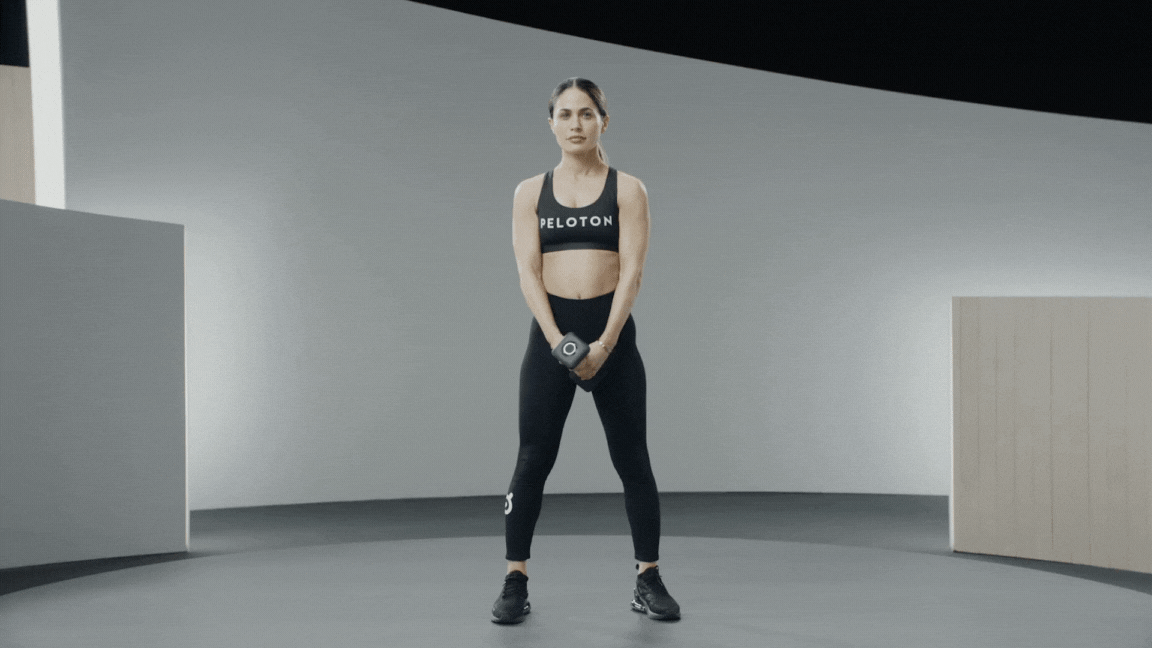
7. Standing Woodchop
Start standing with your feet hip-width distance apart and your knees softly bent, holding a dumbbell with both hands above your left shoulder.
Inhale, then exhale to chop the dumbbell down in a diagonal motion across your body to the outside of your right hip, pivoting your left heel and knee inwards.
Inhale to reverse the movement, lifting the dumbbell diagonally up and to the left to return to the starting position.
Continue for 30 seconds, then repeat on the other side.
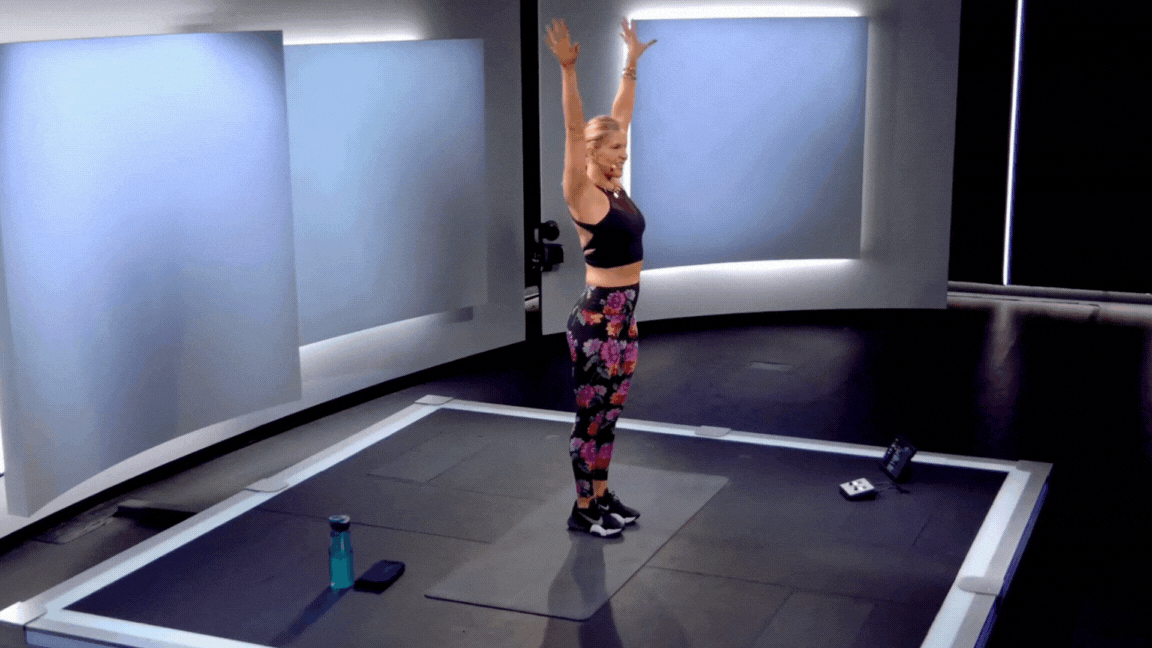
8. Standing Bicycle
Start standing with your feet hip-width apart and your arms extended overhead. (You can also do this move with your hands behind your head, elbow pointing out to the sides.)
Inhale, then exhale to lift your left knee toward your chest, lowering your right elbow to meet your left knee, rounding your spine in a cross-body crunch.
Extend the right arm and return the left foot to the floor, then repeat on the other side, with the right leg and left arm. That’s one rep.
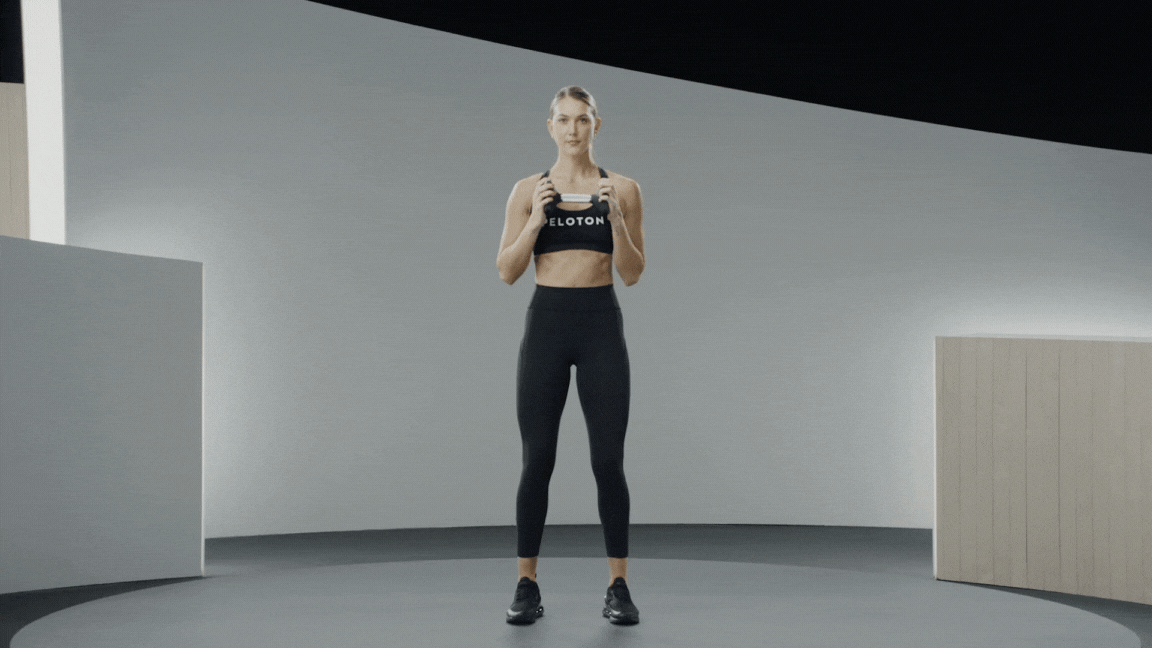
9. Dumbbell Halo
Start standing with your feet shoulder-width distance apart, knees softly bent, holding a dumbbell horizontally in both hands in front of your chest.
Keeping your wrists straight, rotate the dumbbell around your head, moving it from above your left shoulder, behind your head, to above your right shoulder, completing the rotation by bringing the dumbbell back to the starting position in front of your chest. As you rotate, allow your elbows to lift and point up toward the ceiling, but keep your core engaged throughout the movement; don’t allow your back to arch or ribs to flare open.
Repeat, rotating in the opposite direction. That’s one rep.
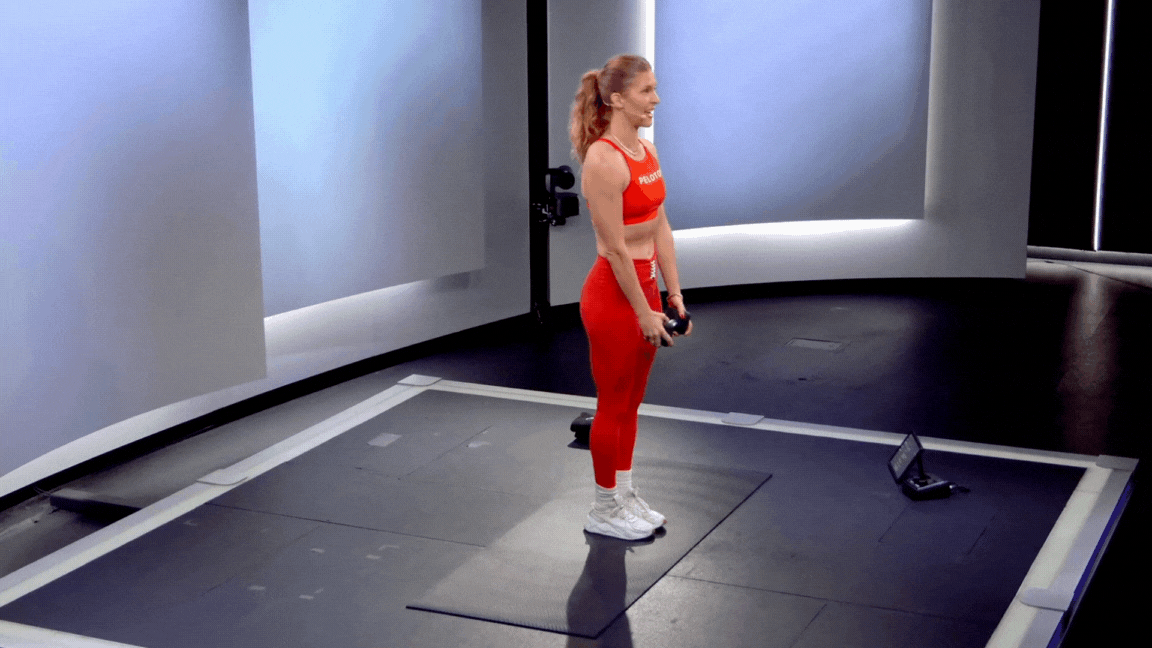
10. Standing Dumbbell Bird Dog
Start standing with your feet together, holding a dumbbell horizontally in both hands in front of your thighs.
Hinge forward at your hips to lean your torso forward, reaching the dumbbell forward and down on a diagonal, while simultaneously reaching your right foot backward to tap your right toes to the floor behind you. Bend your left knee into a quarter squat.
Crunch your right knee in toward your chest and pull the dumbbell down below your shin, rounding your spine and balancing on the left leg.
Hold for one second, then reverse the movement, extending the right leg backward to tap the floor with the right toes, and reaching the dumbbell forward.
Lift your chest, lower the dumbbell in front of your hips, and step the right foot forward next to the left to return to the starting position. That’s one rep.
Repeat on the opposite side. Continue alternating, doing the same number of reps on both sides.
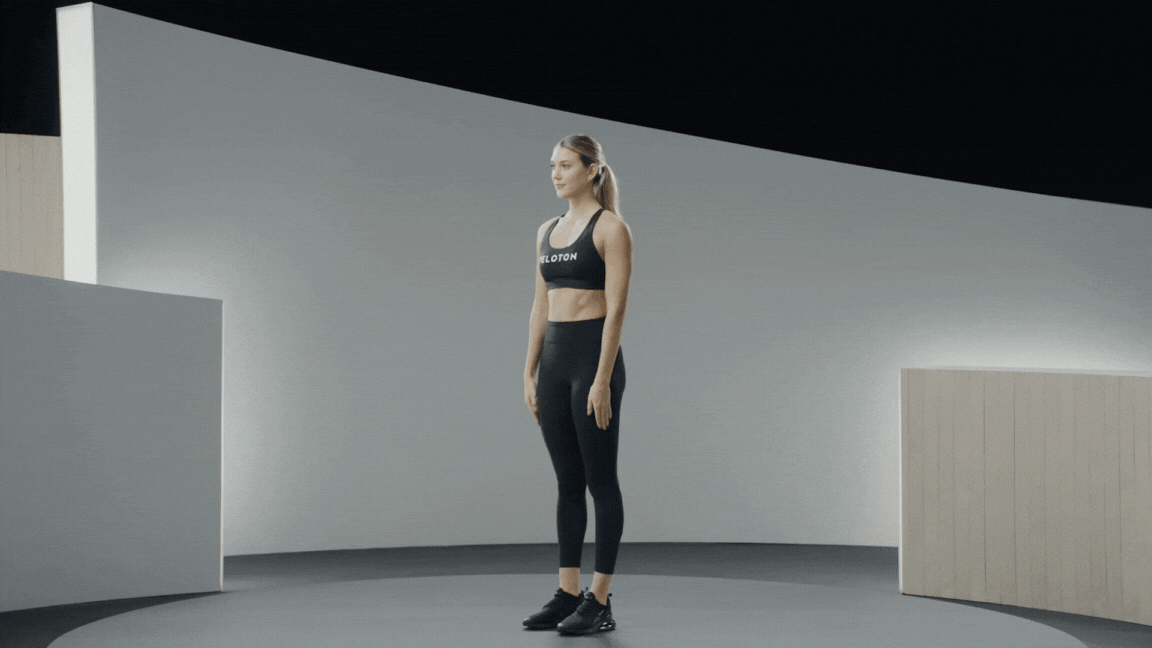
11. Standing Dead Bug
Start standing with your feet together and arms extended forward at shoulder height, palms facing in.
Extend your right leg forward slightly so just your right toes are touching the floor. Reach your left arm overhead, bicep by your ear. Engage your core and focus on maintaining a neutral spine.
Simultaneously lift your right knee up to hip height, bent at 90 degrees, and lower your left arm to chest height while still maintaining a neutral spine and active core.
Lower your right foot to the floor and reach your left arm overhead to return to the starting position without losing the tension in your abs.
That’s one rep. Do the same number of reps on both sides.
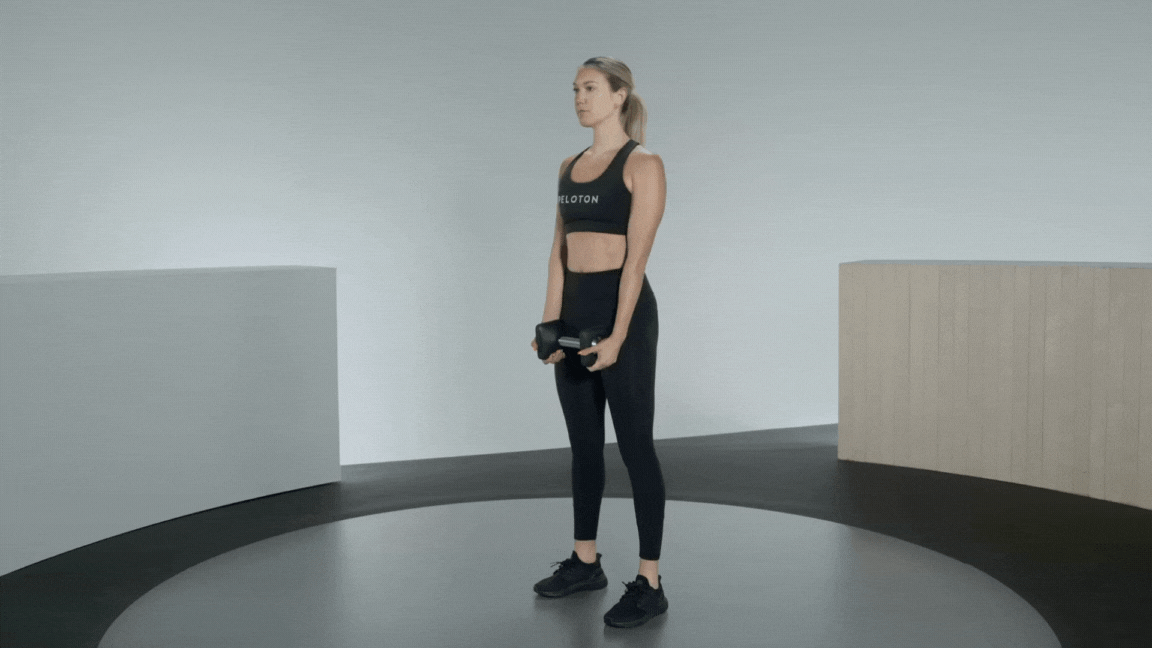
12. Dumbbell Good Morning
Start standing with your feet shoulder-width distance apart, knees softly bent, holding a dumbbell horizontally in both hands in front of your chest. (You can also do this exercise with just your body weight; instead of holding a dumbbell, place your hands behind your head, elbows pointing out.)
Engage your core and hinge at your hips to lean your torso forward, sending your hips back.
Pause when your torso is about parallel to the floor.
Squeeze your glutes to push your hips forward and lift your torso, returning to the starting position. That’s one rep.
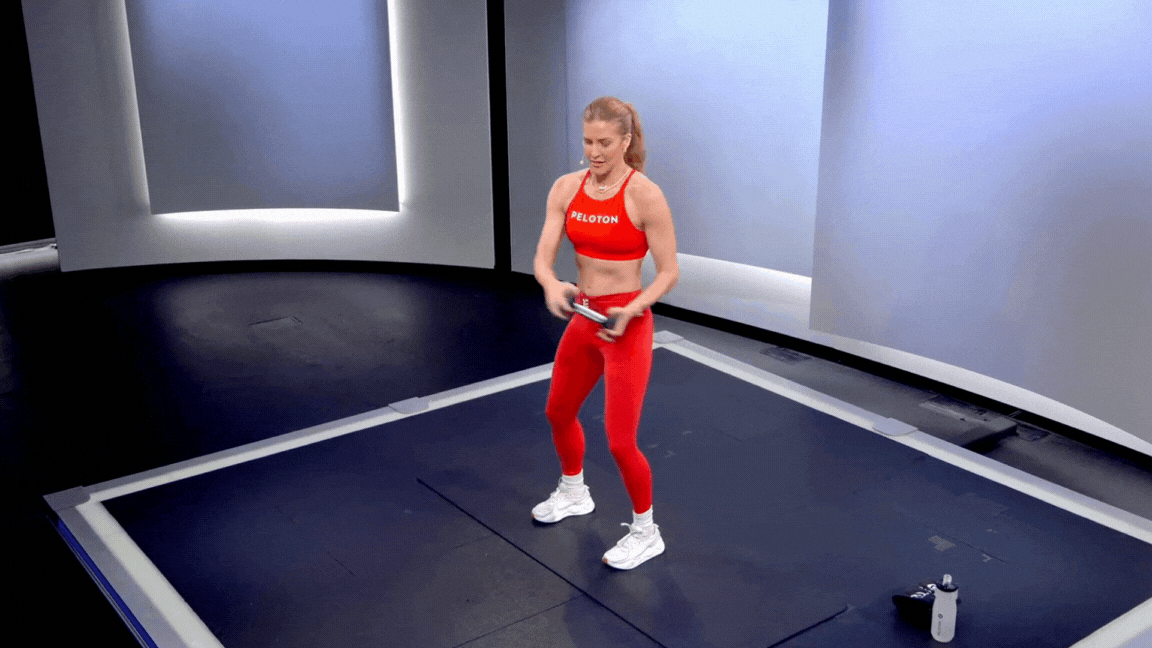
13. Standing Dumbbell Russian Twist
Start standing with your feet about shoulder-width distance apart, knees softly bent, holding a dumbbell horizontally in both hands in front of your belly button. (You can also do this exercise with just your body weight; instead of holding a dumbbell, simply clasp your hands together.)
Inhale and engage your core, then exhale to reach the dumbbell to the outside of your right hip, rotating your shoulders but keeping your hips square to the front.
Inhale to return to center, then exhale to repeat on the other side, reaching the dumbbell to the outside of your left hip.
That’s one rep. Repeat, alternating sides for the desired number of reps.
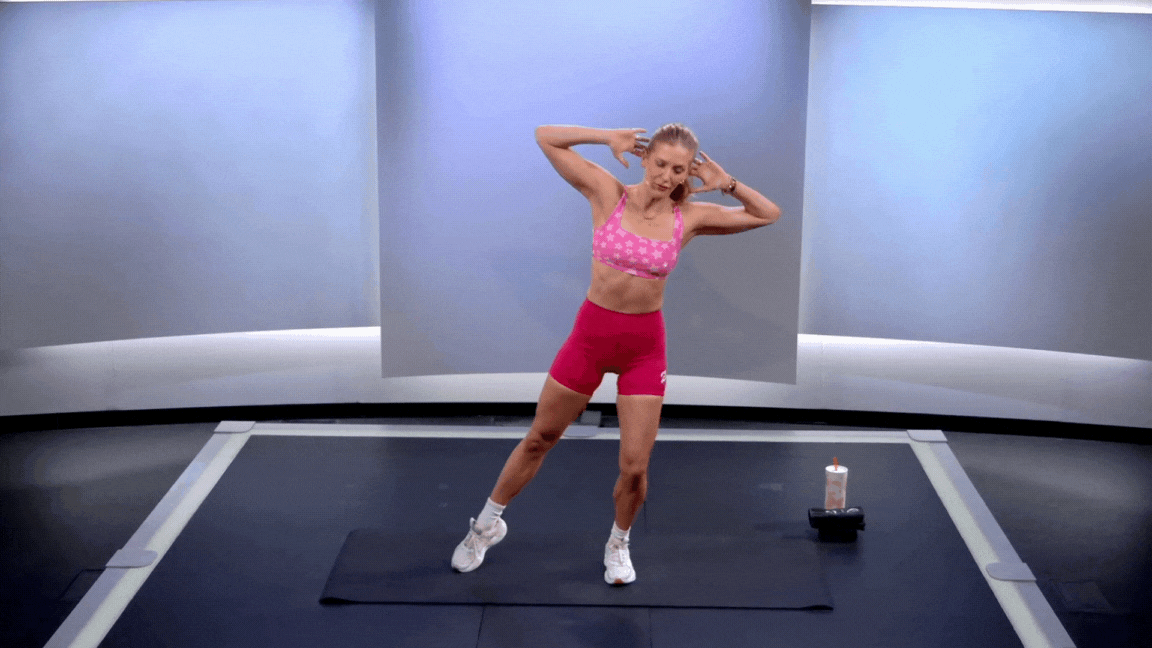
14. Lateral Crunch
Start standing with your feet hip-width distance apart. Shift all your weight into your right leg, bending your right knee. Extend the left leg out to the side so your left toes are just barely touching the floor. Place your hands behind your head, elbows pointing out to the sides.
Bend at the waist to crunch your torso to the left, reaching your left knee up toward your left elbow so you’re balancing on the right foot. Keep your chest and hips square to the front.
If you can, tap your left knee and shoulder together, then straighten your torso, lifting your head and shoulders back to center, and tapping your left foot to the floor. That’s one rep. Do the same number of reps on both sides.
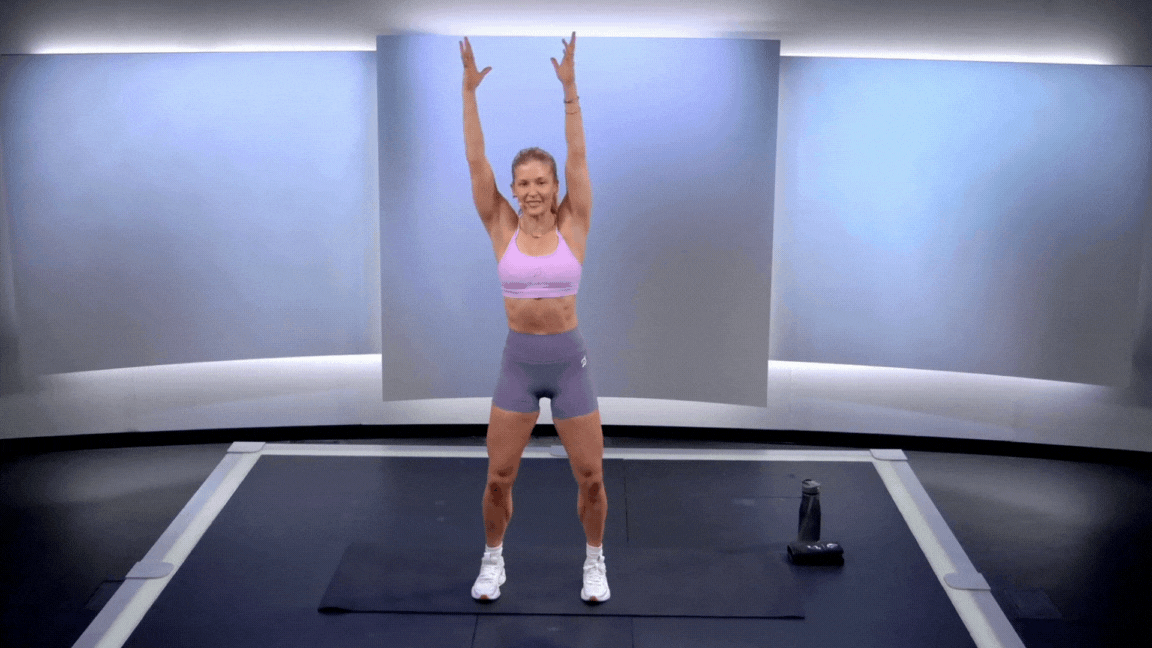
15. Standing Side Bend
Start standing with your feet hip-width distance apart, knees softly bent. Reach your arms overhead, biceps by your ears.
Engage your core, then reach your arms up and over to the right side, bending at your waist. Keep your chest square to the front and don’t move your lower body.
Use your obliques to lift your torso back to center, returning to the starting position.
That’s one rep. Do the same number of reps on both sides.
Are Standing Core Exercises Safe to Do During Pregnancy?
In general, standing core work can be safely included in your prenatal workout routine, especially if you were already doing it pre-pregnancy. “Standing core can be a great option for women who are pregnant, as the movements can accommodate most trimesters,” Rebecca says. Of course, you’ll need to get the all-clear from your doctor first, and don’t hesitate to modify as needed.
In general, it’s a smart idea to include core work in your prenatal routine. A 2023 study published in the Journal of Manipulative & Physiological Therapeutics investigated the effects of 10 weeks of core stability exercises (focusing on the pelvic floor and deep abdominal muscles) in pregnant women with lumbar and pelvic girdle pain. Women who practiced these exercises experienced less pain and reported a higher quality of life than the control group who didn’t perform the core work.
If you’re looking for core workouts that are specifically designed for pregnancy, check out the Prenatal Core Strength classes on the Peloton App.
What Muscles Do Standing Core Exercises Work?
Every exercise is going to engage slightly different muscles. But, in general, standing core exercises will work your core. That’s not just your abs, but all the muscles in your trunk that work to move, support, and stabilize your spine, according to the American Council on Exercise (ACE). According to Agostino, these types of moves primarily work the following core muscles:
Transverse Abdominis: This muscle wraps around your abdomen like a corset and offers deep core stabilization and spinal support.
Internal and External Obliques: These muscles lie on either side of your abdomen and assist with rotation, anti-rotation, and lateral flexion (bending).
Erector Spinae: These back muscles run along the sides of your spine, which helps maintain posture and lower back stability.
All the while, he says that standing core exercises also activate the following secondary muscle groups:
Hip Flexors: These muscles on the front of the hip (Including the psoas, iliacus, and rectus femoris) are critical for knee drive and balance.
Glutes: The gluteus medius and gluteus maximus are engaged in single-leg work and hip stability.
Shoulder Stabilizers: Your deltoids and trapezius (along with other shoulder muscles) work during overhead and anti-rotation movements.
Legs: Given that you’re standing up, your quads, hamstrings, and calves will also work to support your balance and movement.
How to Add Standing Core Exercises to Your Fitness Routine
To maximize the benefits of standing core exercises, heed Agostino’s following tips and tricks:
Volume: “Choose 4–6 exercises per session, completing 2–3 sets of 10–15 reps per movement,” he suggests. Or, to make it even easier, just cue up a standing core strength class on the Peloton App.
Frequency: Agostino advises practicing your standing core circuits two to four times per week, whether as a standalone session or integrated into your strength training routine. (Tip: When possible, opt for the latter. “Standing core exercises pair well with dynamic strength work—e.g., deadlifts, lunges, overhead presses—for a stronger, more functional core,” he shares.)
Progression: Once you’ve nailed the foundations and it’s time to level up your standing core routine, Agostino suggests adding extra challenges like resistance with bands or (heavier) dumbbells, slowing down the pace of your moves, or increasing time under tension—each of which can help you feel an extra burn.
The Takeaway
Mat core work is great, but standing core exercises might be the secret sauce to bring your muscle activation to the next level. Variety is key, and you’ll want to keep your muscles guessing, so it’s worth incorporating a mix of different moves—standing, supine, and otherwise—into your greater fitness routine.
On a parting note, Rebecca offers a gentle reminder to think beyond six-packs and aesthetic value. “When thinking of your core, go beyond the reflection in the mirror,” she advises. “Our core is our powerhouse, housing our lungs and our biggest source of stability.” That said, boosting core strength can empower and equip us to move (and breathe) with more grace, ease, and confidence day in and day out.
This content is for informational and educational purposes only and does not constitute individualized advice. It is not intended to replace professional medical evaluation, diagnosis, or treatment. Seek the advice of your physician for questions you may have regarding your health or a medical condition. If you are having a medical emergency, call your physician or 911 immediately.
Build full-body strength
Enter your email to get articles, instructor tips, and updates from Peloton sent to your inbox.
By providing your email address, you agree to receive marketing communications from Peloton.
For more about how we use your information, see our Privacy Policy.

